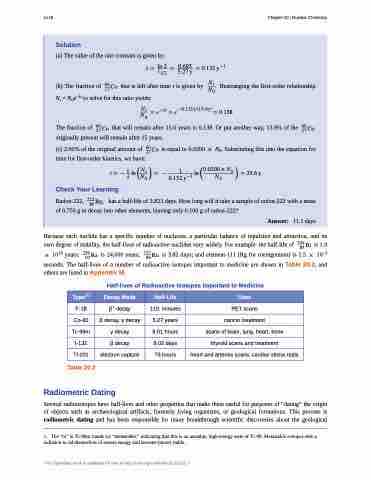Page 1126 - Chemistry--atom first
P. 1126
1116 Chapter 20 | Nuclear Chemistry
Solution
(a) The value of the rate constant is given by:
�� ��� � ����� ��������� ���� ���� �
(b) The fraction of �� �� that is left after time t is given by �� � Rearranging the first-order relationship �� ��
Nt = N0e–λt to solve for this ratio yields:
�� � ���� � ����������������������� � �����
��
The fraction of �� �� that will remain after 15.0 years is 0.138. Or put another way, 13.8% of the �� ��
�� ��
originally present will remain after 15 years.
(c) 2.00% of the original amount of �� �� is equal to 0.0200 � N0. Substituting this into the equation for
time for first-order kinetics, we have:
� ���� � �����������
�� ��������� ������������ �� �������
Check Your Learning
Radon-222, ��� ��� has a half-life of 3.823 days. How long will it take a sample of radon-222 with a mass ��
��
of 0.750 g to decay into other elements, leaving only 0.100 g of radon-222?
Answer: 11.1 days
Because each nuclide has a specific number of nucleons, a particular balance of repulsion and attraction, and its
own degree of stability, the half-lives of radioactive nuclides vary widely. For example: the half-life of ��� �� is 1.9
19 ��� ��� �� –3 � 10 years; �� �� is 24,000 years; �� �� is 3.82 days; and element-111 (Rg for roentgenium) is 1.5 � 10
seconds. The half-lives of a number of radioactive isotopes important to medicine are shown in Table 20.2, and others are listed in Appendix M.
Half-lives of Radioactive Isotopes Important to Medicine
Type[1]
Decay Mode
Half-Life
Uses
F-18
β+ decay
110. minutes
PET scans
Co-60
β decay, γ decay
5.27 years
cancer treatment
Tc-99m
γ decay
8.01 hours
scans of brain, lung, heart, bone
I-131
β decay
8.02 days
thyroid scans and treatment
Tl-201
electron capture
73 hours
heart and arteries scans; cardiac stress tests
Table 20.2
Radiometric Dating
Several radioisotopes have half-lives and other properties that make them useful for purposes of “dating” the origin of objects such as archaeological artifacts, formerly living organisms, or geological formations. This process is radiometric dating and has been responsible for many breakthrough scientific discoveries about the geological
1. The “m” in Tc-99m stands for “metastable,” indicating that this is an unstable, high-energy state of Tc-99. Metastable isotopes emit γ radiation to rid themselves of excess energy and become (more) stable.
This OpenStax book is available for free at http://cnx.org/content/col12012/1.7


